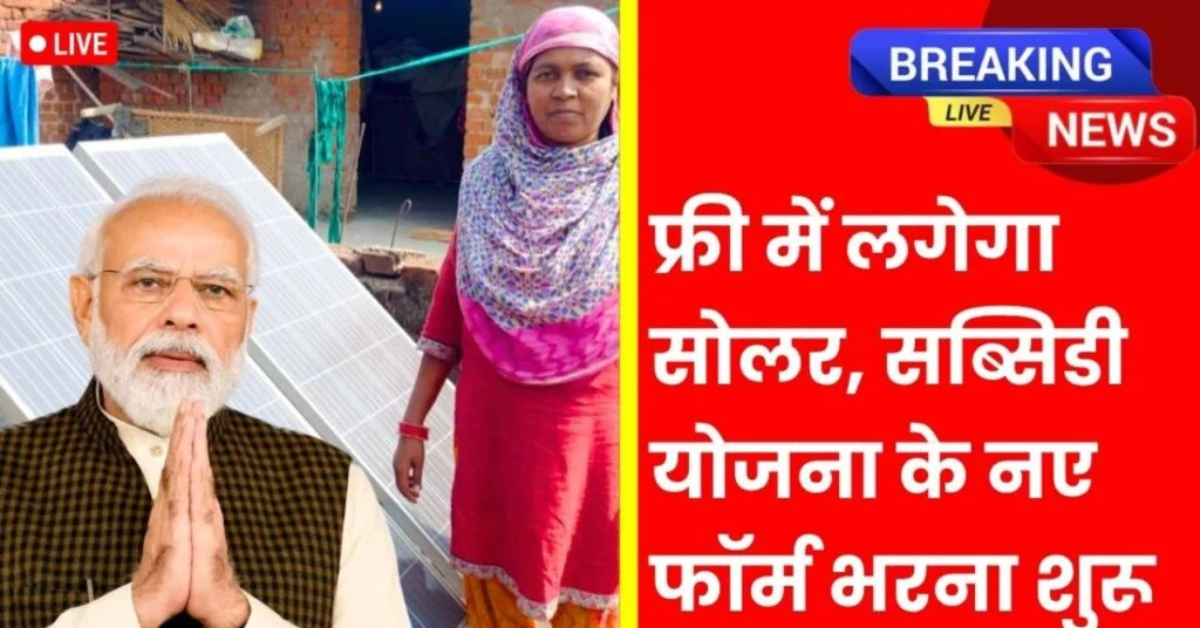The Indian government has officially started the application process for the Solar Rooftop Subsidy Yojana 2025, a scheme that offers huge financial support to households and small businesses for installing solar panels on their rooftops. As part of the nation’s push for clean energy, the scheme is expected to benefit lakhs of families by reducing electricity bills and promoting renewable energy adoption.
With the rising cost of electricity and growing awareness of climate change, this scheme is not just a money-saver—it’s a step toward a greener and self-reliant India.
Let’s explore all the important details: eligibility, subsidy rates, benefits, application process, and more.
🔆 What is the Solar Rooftop Subsidy Yojana?
The Solar Rooftop Yojana is a central government initiative implemented by the Ministry of New and Renewable Energy (MNRE) under the PM Surya Ghar: Muft Bijli Yojana.
It aims to:
- Encourage households to generate electricity using solar panels
- Provide financial assistance (subsidy) to make installation affordable
- Reduce dependence on conventional electricity and fossil fuels
- Enable free electricity up to 300 units/month (for households under specific programs)
🔷 Who is Eligible for the Solar Rooftop Scheme?
The scheme is open to a wide section of the population. However, there are some basic criteria to qualify:
✅ Eligibility Criteria:
- Applicant must be an Indian citizen
- Should be the owner of the house/building
- The rooftop should have adequate space and sunlight for solar panel installation
- The house must have an active electricity connection
- Subsidy is available for residential and certain institutional or social sector buildings
Note: Commercial or industrial buildings are not eligible under the same subsidy rates but may be considered under different programs.
🔆 How Much Subsidy Can You Get?
The subsidy amount depends on the solar capacity (kW) installed:
| Solar Capacity | Subsidy Percentage | Maximum Subsidy |
|---|---|---|
| Up to 3 kW | 60% | ₹30,000 to ₹45,000 approx. |
| 3 kW to 10 kW | 40% (for additional capacity) | ₹78,000 approx. |
| Above 10 kW | No subsidy beyond 10 kW for residential |
The exact subsidy may vary slightly depending on:
- The state (some offer additional top-ups)
- Discom approvals
- Installer rates and vendor quotations
🔷 Key Benefits of Solar Rooftop Subsidy Yojana
| 🔋 Benefit | 🔍 Details |
|---|---|
| 💸 Reduced Electricity Bills | Save ₹1000–₹3000 monthly depending on usage |
| 🏠 Energy Independence | Generate your own power with zero fuel cost |
| 🌱 Eco-Friendly | Reduce your carbon footprint by using clean energy |
| 💰 Government Subsidy | Up to 60% subsidy makes solar affordable |
| ⬆ Property Value Increase | Solar-ready homes attract better resale value |
| ⚡ Net Metering | Sell extra energy back to the grid and earn credit |
| 🔧 Low Maintenance | Solar panels have 20–25 years of life with minimal upkeep |
🔶 Documents Required for Application
To apply for the subsidy, keep these documents ready:
- Aadhaar Card (linked with mobile number)
- Electricity bill (latest)
- Property ownership proof (property tax receipt or registry)
- Bank passbook (for subsidy transfer)
- Passport size photo
- Active mobile number and email ID
In case of rented properties, owner’s consent and ID proof are also required.
🔷 How to Apply for Solar Rooftop Subsidy Yojana?
The government has made the application process fully online and user-friendly.
📝 Step-by-Step Application Process:
- Visit the official portal:
Go to https://pmsuryaghar.gov.in – the official MNRE portal. - Register using your mobile number and email ID.
- Select your electricity distribution company (DISCOM) and provide your consumer number (from your electricity bill).
- Fill in personal and property details – name, address, roof type, solar capacity (1 kW to 10 kW), etc.
- Choose a vendor/installer approved by the DISCOM.
- Upload documents – Aadhaar, photo, electricity bill, bank passbook.
- Submit the application and wait for DISCOM approval.
- After approval, install the solar system through the selected vendor.
- Submit installation proof (photos, invoice, net meter connection).
- Receive the subsidy directly in your bank account within 30–60 days.
🔆 How Much Area Is Needed for Solar Installation?
On average, 1 kilowatt (kW) solar panel system needs around 100 sq. ft. of shadow-free rooftop space. So:
- 3 kW system = 300 sq. ft.
- 5 kW system = 500 sq. ft.
- 10 kW system = 1000 sq. ft.
Most middle-income urban homes can easily accommodate 3 to 5 kW systems, which is sufficient for daily power needs.
🔶 States Offering Additional Benefits
Some states offer extra incentives in addition to the central subsidy:
- Gujarat: Up to ₹10,000 additional subsidy per kW
- Maharashtra: Discounts on net metering charges
- Delhi: Time-bound approvals and interest-free loans
- Tamil Nadu & Kerala: Fast-track subsidy disbursements
Always check with your local electricity department or state renewable energy agency for region-specific advantages.
🔷 Net Metering: Earn from Excess Electricity
One of the biggest advantages of going solar is net metering. Under this:
- You can sell excess power generated by your panels to the electricity grid
- The amount gets credited to your electricity bill
- In some cases, you can even earn a monthly refund if your production is more than consumption
This makes rooftop solar not just a saving tool, but also a small earning opportunity.
✅ Conclusion
The Solar Rooftop Subsidy Yojana 2025 is a golden opportunity for Indian households to cut electricity bills, increase savings, and contribute to a greener India. With the application window now open, eligible citizens are advised to act fast and submit their applications online to benefit from the generous central and state subsidies.
If you’ve been thinking about going solar, there’s no better time than now. With the government covering up to 60% of your cost, your investment pays back within just a few years—followed by decades of free electricity.

